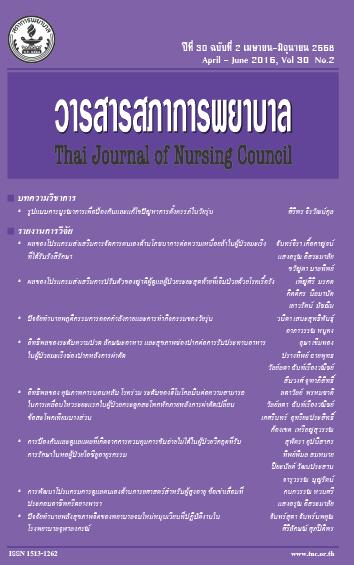การป้องกันและดูแลแผลที่เกิดจากการควบคุมการขับถ่ายไม่ได้ใน ผู้ป่วยวิกฤตที่รับการรักษาในหอผู้ป่วยไอซียูอายุรกรรม
Keywords:
คำสำคัญ, การป้องกัน การดูแลแผล แผลที่เกิดจากการควบคุมการขับถ่ายไม่ได้ ไอซียูอายุรกรรม Keywords, prevention, wound care, incontinence-associated dermatitis (IAD), medical ward, intensive care unitAbstract
บทคัดย่อ:วัตถุประสงค์ของการวิจัย: เพื่อศึกษา 1) สภาพปัญหาของการพยาบาล 2) พัฒนารูปแบบการพยาบาลเพื่อป้องกันและดูแลแผลที่เกิดจากการควบคุมการขับถ่ายไม่ได้ในผู้ป่วยวิกฤต (incontinence associated-dermatitis; IAD) และ 3) เปรียบเทียบอัตราการเกิดแผลก่อนและหลังใช้รูปแบบการพยาบาลที่ได้พัฒนาขึ้น
การออกแบบวิจัย: การวิจัยเชิงคุณภาพแบบเชิงปฏิบัติการแบบมีส่วนร่วม
การดาเนินการวิจัย: แบ่งการศึกษาเป็น 4 ระยะ 1) การวางแผน 2) การปฏิบัติ 3) การสังเกต และ 4) การสะท้อนการปฏิบัติและการปรับปรุงแผน เก็บข้อมูลโดยการสนทนากลุ่ม การสังเกตแบบมีส่วนร่วม การสืบค้นข้อมูลจากหลักฐานเชิงประจักษ์ และอัตราการเกิดแผล กลุ่มตัวอย่างคือ ทีมการพยาบาลที่ปฏิบัติงานในหอผู้ป่วยไอซียูอายุรกรรม จานวน 64 คน วิเคราะห์ข้อมูลโดยแจกแจงความถี่ ค่าร้อยละ และวิเคราะห์เชิงเนื้อหา
ผลการวิจัย: ทีมการพยาบาลมีความต้องการแก้ปัญหาการเกิดแผล IAD โดยกำหนดเป็นตัวชี้วัดทางการพยาบาลซึ่งถือเป็นทัศนคติที่ดีต่อการดาเนินการ และต้องการความรู้รวมถึงแนวทางปฏิบัติการพยาบาลในการป้องกันและดูแลแผล IAD ตัวชี้วัดหลักของรูปแบบการพยาบาลประกอบด้วย 1) การประเมินความเสี่ยงต่อการเกิดแผล IAD และ 2) การดูแลผิวหนังเพื่อป้องกันการเกิดแผลและการดูแลแผล IAD มีการปรับปรุงรายละเอียดรูปแบบการพยาบาลอีก 3 ครั้งแล้วพบว่าอัตราการเกิดแผล IAD ในหอผู้ป่วยไอซียูอายุรกรรมลดลงจากร้อยละ 33.33 เหลือร้อยละ 11.24 เป็นแผลระดับผื่นแดงเล็กน้อยร้อยละ 80 และระดับผื่นแดงปานกลางร้อยละ 20 ไม่พบแผลระดับผื่นแดงมากและระดับติดเชื้อ
ข้อเสนอแนะ: การป้องกันและดูแลแผลที่เกิดจากการควบคุมการขับถ่ายไม่ได้ต้องเริ่มจากการมีทัศนคติที่ดี ให้ความรู้อย่างต่อเนื่องและ มีเป้าหมายร่วมกันจึงสามารถลดอัตราการเกิดแผลได้
Abstract: Objective: To (i) study nursing problems; (ii) develop a nursing programme contributing to prevention and treatment of incontinence-associated dermatitis (IAD) in critical patients; and (iii) compare IAD formation rates before and after the implementation of the programme.
Design: Participatory action research.
Implementation: The study was conducted in 4 phases: (i) programme planning; (ii) programme implementation; (iii) programme observation; and (iv) programme reflection and improvement. Data were collected by means of group interviews, participatory observation, empirical evidence research, and studying IAD formation rates. The subjects were 64 members of the nursing team in a medical ward’s ICU. The data were analysed in terms of frequency and percentage distribution, and by means of content analysis.
Results: To solve the problem of IAD, the nursing team formulated a set of nursing care indices based on its members’ understanding of this form of nursing service, need for increased knowledge, and need for caregiving guidelines for preventing and treating IAD. Key indices included (i) IAD risk assessment, and (ii) dermatological care to prevent and treat IAD. The nursing programme was adjusted three times before being implemented. After the experiment, it was observed that the rates of IAD had decreased from 33.33% to 11.24%. Of all the IAD cases, only mild rashes (80%) and moderate rashes (20%) were found; neither severe nor infected rashes were found.
Recommendations: Positive attitudes, consistent education, and goal-sharing contribute significantly to the prevention and decrease of incontinence-associated dermatitis.
คำสำคัญ : การป้องกัน การดูแลแผล แผลที่เกิดจากการควบคุมการขับถ่ายไม่ได้ ไอซียูอายุรกรรม
Keywords: prevention; wound care; incontinence-associated dermatitis (IAD); medical ward; intensive care unit







